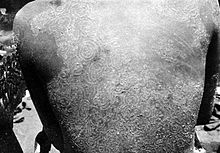Tinea imbricata
| Tinea imbricata | |
|---|---|
| Other names | Tokelau[1] |
 | |
| Tinea imbricata | |
| Specialty | Dermatology |
Tinea imbricata (also known in parts of Indonesia as “Kaskado”) is a superficial fungal infection of the skin limited to southwest Polynesia, Melanesia, Southeast Asia, India, and Central America.[1]: 303 [2] The skin lesions, often itchy, occur mainly in the torso and limbs.[3] The name tinea imbricata is derived from the Latin for "tiled" (imbricatus) since the lesions are often lamellar.[4] The lesions are often treated with griseofulvin or terbinafine.[4]
The condition has also become known as "Tokelau" - the name apparently references the islands of Tokelau in the South Pacific.[5]
The risk of developing tinea imbricata is probably inherited as an autosomal recessive trait.[6][7]
Tinea imbricata is associated with Trichophyton concentricum.[4]
Tinea pseudoimbricata
[edit]The term "tinea pseudoimbricata" synonymous with "tinea indecisiva", was coined to describe a form of tinea mimicking the concentric rings of tinea imbricata, but is caused by local or systemic immunosuppression.[8] Since then, 3 cases of Trichophyton tonsurans have been associated with it,[9] as well as Trichophyton rubrum which can trigger mycosis fungoides.[10][11] Mixed infections with scabies have been described to produce tinea pseudoimbricata.[12][13]
As of 2015 in India, corticosteroid–antifungal–antibacterial combinations sold as over-the-counter drug have led to an increase in chronic, recurrent, difficult to treat fungal infections of the skin, including tinea pseudoimbricata.[14]
See also
[edit]References
[edit]- ^ a b James WD, Berger TG, et al. (2006). Andrews' Diseases of the Skin: clinical Dermatology. Saunders Elsevier. ISBN 0-7216-2921-0.
- ^ Rapini RP, Bolognia JL, Jorizzo JL (2007). Dermatology: 2-Volume Set. St. Louis: Mosby. p. 285. ISBN 978-1-4160-2999-1.
- ^ Burns C, Valentine J (December 2016). "Tinea Imbricata". The New England Journal of Medicine. 375 (23): 2272. doi:10.1056/nejmicm1516757. PMID 27959674.
- ^ a b c Bonifaz A, Archer-Dubon C, Saúl A (July 2004). "Tinea imbricata or Tokelau". International Journal of Dermatology. 43 (7): 506–10. doi:10.1111/j.1365-4632.2004.02171.x. PMID 15230889. S2CID 45272404.
- ^
Schiefenhövel, Wulf (22 November 2013). "Cassia Alata - Plädoyer für die Reaktivierung eines traditionellen Heilmittels im westichen Pazifik". In Schröder, Ekkehard (ed.). Ethnobotanik—Ethnobotany: Beiträge und Nachträge zur 5. Internationalen Fachkonferenz Ethnomedizin in Freiburg, 30.11.–3.12.1980 (in German). Wiesbaden: Springer-Verlag. p. 144. ISBN 9783663141327. Retrieved 7 March 2024.
Reisenden in pazifischen Länder fällt häufig eine Hautpilzerkrankung der Einheimishen auf, die insbesondere in den feuchtheissen Küstenzonen vorkommt [...]. Die gängigen dermatologischen Bezeichnungen für diese Hautinfektion sind Tinea imbricata und Tokelau. Die Bewohner der Tokelau Gruppe nördlich von Samoa waren möglicherweise besonders häufig von der Tinea imbricata betroffen, so daß ihre Insel zum Synonym für diese Trichophytie wurde.
- ^ Serjeantson S, Lawrence G (January 1977). "Autosomal recessive inheritance of susceptibility to tinea imbricata". Lancet. 1 (8001): 13–5. doi:10.1016/s0140-6736(77)91653-1. PMID 63655. S2CID 27447510.
- ^ Ravine D, Turner KJ, Alpers MP (October 1980). "Genetic inheritance of susceptibility to tinea imbricata". Journal of Medical Genetics. 17 (5): 342–8. doi:10.1136/jmg.17.5.342. PMC 1048596. PMID 7218274.
- ^ Lim S. P. R., Smith A. G. (2003). "Tinea corporis in a renal transplant recipient mimicking the concentric rings of tinea imbricata". Clinical and Experimental Dermatology. 28 (3): 332–3. doi:10.1046/j.1365-2230.2003.01281.x. PMID 12780732. S2CID 30983522.
- ^ Ouchi T1, Nagao K, Hata Y, Otuka T, Inazumi T. Trichophyton tonsurans infection manifesting as multiple concentric annular erythemas. J Dermatol. 2005 Jul;32(7):565-8.
- ^ Poonawalla T, Chen W, Duvic M (2006). "Mycosis fungoides with tinea pseudoimbricata owing to Trichophyton rubrum infection". J Cutan Med Surg. 10 (1): 52–6. doi:10.1007/7140.2006.00007. PMID 17241575. S2CID 208341303.
{{cite journal}}: CS1 maint: multiple names: authors list (link) - ^ Verma S, Hay RJ (2015). "Topical steroid-induced tinea pseudoimbricata: a striking form of tinea incognito". Int J Dermatol. 54 (5): e192–3. doi:10.1111/ijd.12734. PMID 25601089. S2CID 31276542.
- ^ Poziomczyk CS, Köche B, Becker FL, Dornelles SI, Bonamigo RR. Tinea pseudoimbricata caused by M. gypseum associated to crusted scabies.An Bras Dermatol. 2010 Jul-Aug;85(4):558-9.[English, Portuguese]
- ^ Verma S (2017). "Tinea pseudoimbricata". Indian J Dermatol Venereol Leprol. 83 (3): 344–345. doi:10.4103/0378-6323.187686. PMID 27506504.
- ^ Bishnoi Anuradha; et al. (2018). "Emergence of recalcitrant dermatophytosis in India". The Lancet Infectious Diseases. 18 (3): 250–251. doi:10.1016/S1473-3099(18)30079-3. PMID 29485088.
